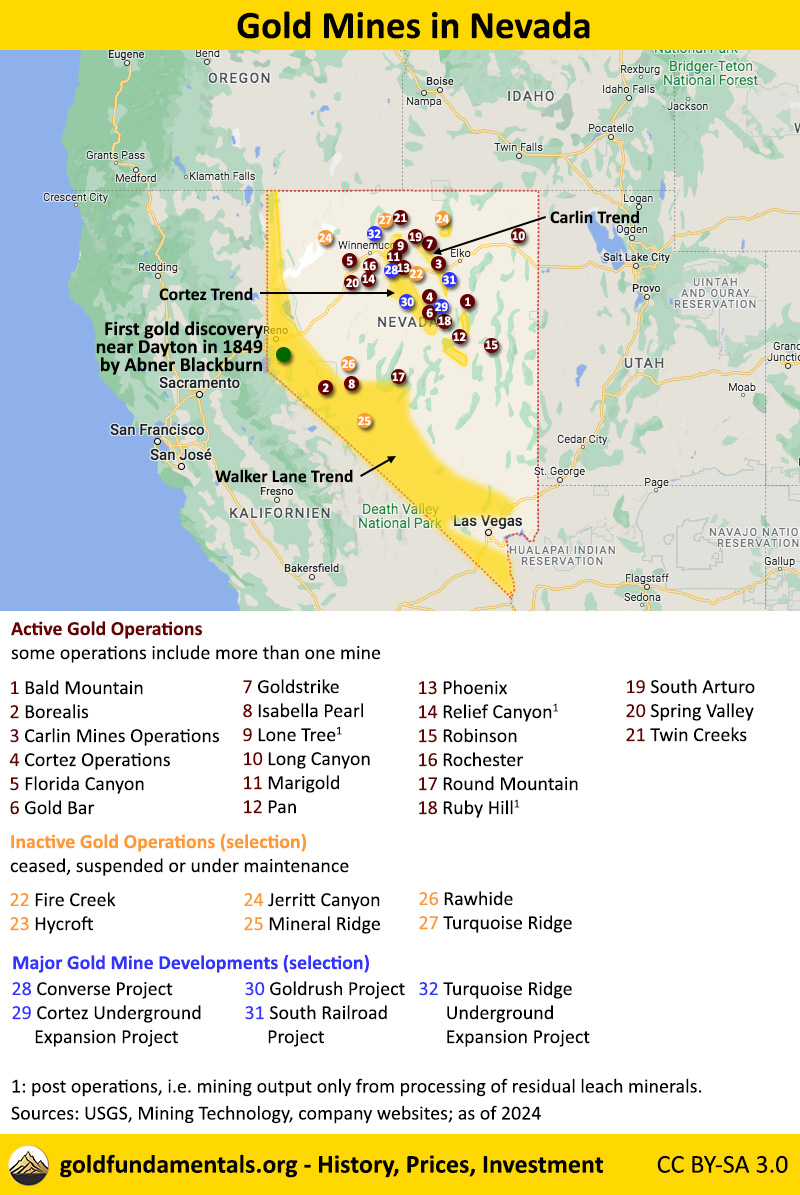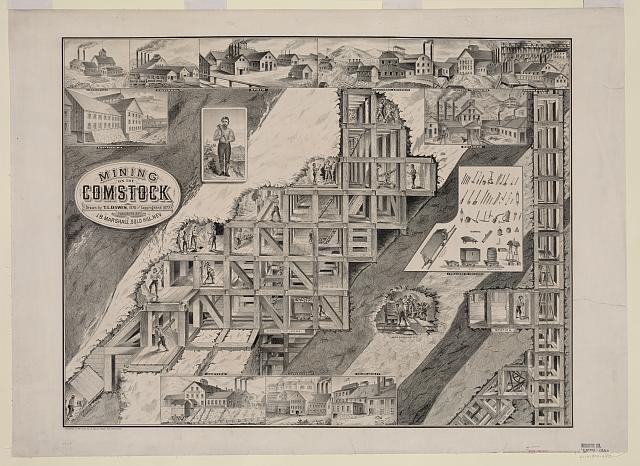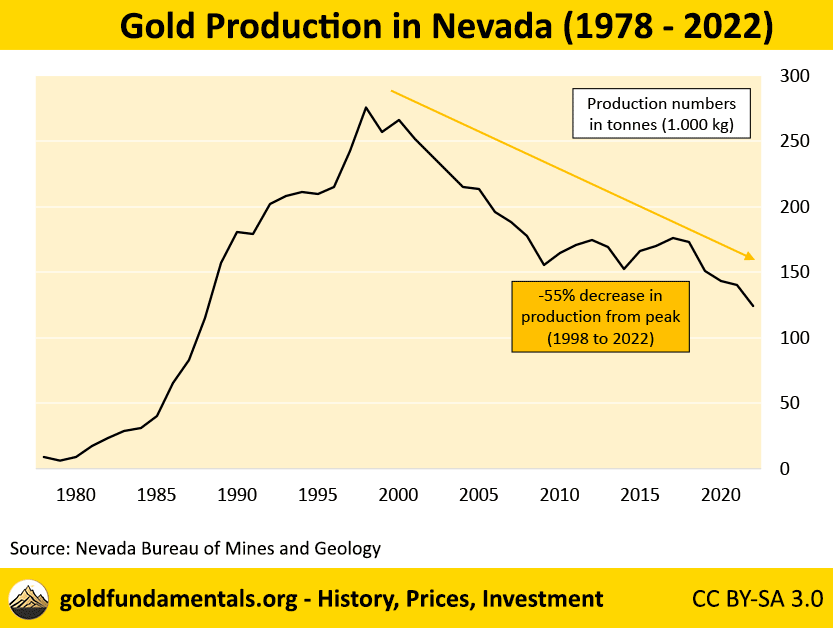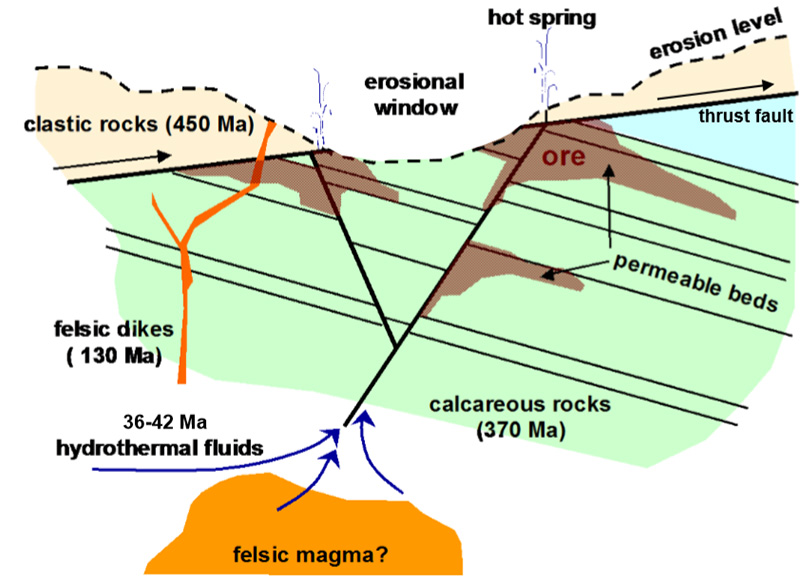
Nevada is the main gold producer in the United States. Read in the article about the history of gold mining in Nevada, about its major active gold mines and other facts and figures about gold mining in NV.
Contents
- Is there Gold in Nevada?
- Where is Gold in Nevada?
- Why is there so Much Gold in Nevada?
- What is the History of Gold Mining in Nevada?
- How Much Gold Has Been Mined in Nevada?
- What is the Current State of Gold Mining in Nevada?
- What Companies Mine Gold in Nevada?
- Where are New Gold Mines Explored or Developed in Nevada?
- What are the Gold Reserves in Nevada?
- Is it Legal to Mine Gold in Nevada?
- Where Can I Pan for Gold in Nevada?
- Is there Gold in Other US States?
Is there Gold in Nevada?
Yes. Gold production is mainly in the central north, between Winnemucca and Elko (see map).
Nevada is a major player in the gold mining industry. The state’s gold production in 2022 was 124 tonnes representing 72% of US gold and 5% of the world’s production. From a peak nearly 280 tonnes (9m troy ounce) in 1998 the production is on a steady decline to now less than half that number (see chart). Currently there are 17 operators and 27 mining operations (each operations can consist of more than one mine); of which 5 recently became inactive. Mining is mostly open pit but also underground. (see map). The US Geological Survey lists more than 7,000 mines with gold deposits in Nevada.
Key Takeaways:
| Fact | Explanation |
|---|---|
| Remember | By far the biggest gold producer in the US; historically known for its silver deposits |
| Gold Deposits | Yes |
| Discovery Year | 1849 |
| Discoverer | Abner Blackburn |
| Gold Mining Industry | Still active |
| Major Gold Locations | Mostly in the north; three trends: Cortez, Calin and Walker Lane |
| Major Active Mines | 27 operations open pit and underground, each with one or more mines |
| Mining Companies | 17 mining companies including the world-biggest producers Barrick and Newmont as the joint venture Nevada Gold Mines |
| Panning Locations | Placer districts in Northern Nevada |
If Nevada was a country, it would put them at the seventh position of gold producing countries, on par with Mexico. In terms of gold production per unit area, the state would lead the country ranking. Meaning no other country produces as much gold per area as Nevada; followed by Ghana and Uzbekistan.
Where is Gold in Nevada?
Nevada’s gold mining industry is primarily focused on three key geological trends:
- Cortez Trend
- Carlin Trend
- Walker Lane Trend
The majority of the state’s gold production comes from the Cortez and Carlin Trends, where mines extract low-grade gold from Carlin Type Gold deposits. The gold in Carlin-type deposits is extremely fine-grained, often invisible to the naked eye (known as “invisible gold”); see image. The represent one of the largest gold deposits in the world.

The world’s largest gold mining complex is located on the Carlin Trend, comprising eight mines, along with their infrastructure and processing facilities. It is operated by Nevada Gold Mines, a joint venture between Barrick and Newmont.

Nevada’s unique geology, characterized by fault-dominated mountain ranges and valleys, has contributed to its prolific gold production and potential for further discoveries. The state’s diverse geological landscape, combined with its favorable mining regulations and infrastructure, makes it an attractive destination for exploration companies.
Sources: USGS 1, USGS 2, visualcapitalist
Why is there so Much Gold in Nevada?
What is the History of Gold Mining in Nevada?
Mining in Nevada commenced with native populations extracting minerals like obsidian and turquoise more than 10,000 years ago.
Who Discovered Gold in Nevada?
The history of gold mining in Nevada dates back to the mid-19th century, with the first gold discovery in the area made in July 1849 by Abner Blackburn, a former member of the Mormon Battalion. This discovery, near present-day Dayton, led to the continuous occupation of Gold Canyon’s mouth and the establishment of Nevada’s first non-Native American settlement.

By the spring of 1851, around 200 placer miners, including James “Old Virginny” Finney, were working in the area, and Dayton, also known as Chinatown, became a mineral milling, commercial, and agricultural center. The discovery of gold in the Carson River and the subsequent findings along the ravine, which carried away the wash of Mt. Davidson, led to the establishment of other gold mining towns in Nevada.
The pivotal year of 1859 saw the discovery of the Comstock Lode, which not only contained silver but also significant quantities of gold, marking a turning point in Nevada’s mining history.

Despite the reputation for silver, new gold mining towns were established continually throughout Nevada from the 1860s through the 1920s. Some of the notable gold mining towns in Nevada include:
- Gold Canon (1849): Nevada’s first placer mining settlement
- Delamar (1890s): Became one of the state’s most valuable mining centers during a time of depression in the Nevada mining industry
- Carlin Trend (1960s): The discovery of gold in this region in northeastern Nevada marked the beginning of a modern gold mining boom
Sources: SHPO, NBMG, Legends of America, Nevada Mining
How Much Gold Has Been Mined in Nevada?
Between 1835 and 2022 more than 7,000 tonnes of gold have been mined in Nevada.
This is worth around US$437 billion at 2023 values of gold.However, at the time of prodction, the gold value was much lower, with a range of $35 dollars to more than $2000 per ounce.

What is the Current State of Gold Mining in Nevada?
Check out the video about gold mining in Nevada:
Transitioning from its historical silver notoriety to a gold-focused industry, Nevada’s mining sector has remained a cornerstone of the state’s economy into the 21st century. The mid-1960s marked the beginning of the state’s dominance as one of the world’s largest gold producers. Today, Nevada’s mining operations support various modern industries, including renewable energy and advanced manufacturing, and continue to influence global markets.
Notable gold mining companies in Nevada are two largest gold producers in the United States and the world: Barrick Gold and Newmont Corporation. They operate through a joint venture in the state, joint venture Nevada Gold Mines LLC. Other major producers are Kinross Gold, Coeur Mining and Hecla Mining.

After a peak of nearly 280 tonnes of gold mined in 1998, the production steadily decreased to 124 tonnes in 2022. Also the rate of discovery of new goldfields is decreasing.
How many people work in gold mining in Nevada?
According to Nevada’s Governer’s Office, there were 9,844 people directly employed in gold mining in 2022. Then years earlier, in 2012, the number stood at 10,500 people. Mining, gold mining employment decreased by around 6%.
Source: Nevada Governor’s Office
What is the average salary in the gold mining in Nevada?
In 2022 the average salary in gold mining was $138,567. This is around 5% higher than the average salary in mining in general in Nevada, which was $129,860.
Source: Nevada Governor’s Office
What is the biggest gold mine in Nevada?
The biggest mining complex in Nevada is the Cortez complex which is owned and operated by Nevada Gold Mines (joint venture between Barrick Gold and Newmont); see below for more information.

The biggest gold producer in the world is Nevada Gold Mines The company owns and operates 8 mining operations in the state, each more one or more gold mines.
What are major active gold mines in Nevada?
The US Geological Survey Minerals Yearbook lists in its most recent overview 27 leading gold producing operations in the state of Nevada, based on publicly available information. Production numbers are from 2021, the last reported year. Since then, of the 27 operations, 6 are inactive (ceased, under maintenance or suspended). Of the remaining 21, three have stopped excavation and are processing gold only of residual leach minerals.
With 27 operations, Nevada has by far the most gold operations in the Minerals Yearbook.
The other states are Alaska with 4 operations, California and Arizona each with 3. Only one gold operation is in the states of New Mexico, South Carolina, South Dakota, Michigan, Utah and Colorado.
Complete list and facts and figures of the 27 major gold mining operations in Nevada (21 active, 6 under maintenance or closed as of 2024):
| US Rank | Operation | County and State | Majority Owner (2024) |
Qty 2020 | Qty 2021 |
|---|---|---|---|---|---|
| 1 | Cortez Operations | Elko, Eureka, and Humboldt, NV | Nevada Gold Mines LLC | 24.800 | 26.900 |
| 2 | Carlin Mines Operations | Elko and Eureka, NV | Nevada Gold Mines LLC | 26.700 | 23.500 |
| 3 | Goldstrike | Elko and Eureka, NV | Nevada Gold Mines LLC | 23.100 | 21.900 |
| 4 | Turquoise Ridge1 | Humboldt, NV | Nevada Gold Mines LLC | 9.750 | 10.200 |
| 6 | Long Canyon | Elko, NV | Nevada Gold Mines LLC | 8.110 | 8.120 |
| 7 | Round Mountain | Nye, NV | Kinross Gold Corp. | 10.100 | 7.990 |
| 8 | Marigold | Humboldt, NV | SSR Mining Inc. | 7.290 | 7.320 |
| 10 | Twin Creeks | Humboldt, NV | Nevada Gold Mines LLC | 6.930 | 6.720 |
| 11 | Bald Mountain | White Pine, NV | Kinross Gold Corp. | 5.950 | 6.370 |
| 14 | Phoenix | Lander, NV | Nevada Gold Mines LLC | 6.380 | 5.380 |
| 18 | Jerritt Canyon1 | Elko, NV | First Majestic | 3.530 | 3.060 |
| 20 | Hycroft1 | Humboldt and Pershing, NV | Hycroft Mining Co. | 852 | 1.730 |
| 21 | Florida Canyon | Pershing, NV | Argonaut Gold Inc. | 1.440 | 1.680 |
| 22 | Isabella Pearl | Mineral, NV | Fortitude Gold Corp. | 888 | 1.450 |
| 24 | Pan | White Pine, NV | Calibre Mining Corp. | 1.450 | 1.420 |
| 25 | Gold Bar | Eureka, NV | McEwen Mining Inc. | 868 | 1.360 |
| 26 | Robinson | White Pine, NV | KGHM International Ltd. | 1.200 | 1.280 |
| 28 | Rochester | Humboldt and Pershing, NV | Coeur Mining, Inc. | 844 | 841 |
| 30 | Rawhide1 | Mineral, NV | Coral Reef Capital L.L.C. | 748 | 722 |
| 31 | Fire Creek1 | Lander, NV | Hecla Mining Co. | 989 | 645 |
| 32 | Lone Tree2 | Humbolt, NV | i-80 Gold Corp | — | 273 |
| 33 | Ruby Hill2 | Eureka, NV | i-80 Gold Corp | 103 | 269 |
| 34 | Relief Canyon2 | Pershing, NV | Americas Gold and Silver Corp. | 158 | 168 |
| 35 | South Arturo | Elko, NV | Nevada Gold Mines LLC | 1.890 | 165 |
| 37 | Borealis | Mineral, NV | Waterton Global Resource Management, Inc. | 10 | 122 |
| 38 | Mineral Ridge1 | Esmeralda, NV | Scorpio Gold Corp. | 86 | 57 |
| 39 | Spring Valley | Lyon, NV | Geo-Nevada Inc. | — | 3 |
Explanation:
Rank: a comparison of the output of US mines. Therefore, Cortez operations, with the highest output of the Nevada mines, is ranked number 1 of all US gold mines. Eight of the ten biggest mines are in Nevada. The remaining two are in Arkansas and Colorado.
Quantity: in kilogram; there are approx. 32 fine ounces in one kilogram
1: ceased, suspended or under maintenance
2: mining operations ceased, leaching mining continuing
What are the major active gold mines in Nevada?

Based on the table above, the following overview lists only the gold operations that are still active. Listed by annual gold output:
- Cortez Operations: in the counties Elko, Eureka and Humboldt. Owned by the joint venture Nevada Gold Mines. It consists of the open pit Pipeline and Crossroads mines; and the mine at Cortez Hill which is mined both open pit and underground. The mountain has been mined since 1862, with different operations commencements and closings throughout the times. In 2021, the operation produced 26,900 kilos of gold. Mine Life until 2042.
- Carlin Mines Operations: in the counties of Elko and Eureka. Owned by the joint venture Nevada Gold Mines. Newmont started mining in Carlin in 1965. The complex consists of open pit and underground mining, advanced projects and seven processing facilities. It includes the Leeville underground mine, the Pete Bajo/Fence underground mine, the Exodus underground mine, the Genesis/Tri-Star Complex open pits (Goldstar and Silverstar), the Gold Quarry open pit, Emigrant open pit, and the satellite open pit deposits (Perry and Green Lantern). In 2021 the gold output in kilogram was 23,500. Mine Life 2045.
- Goldstrike: located in Elko and Eureka county. Owned by the joint venture Nevada Gold Mines. Gold was first discovered in 1962 by Atlas Minerals. It borders the Carlin Mine Complex. Goldstrike consists of three major mines: Betze-Post open-pit mine, and the Meikle and Rodeo underground mines. In 2021 Goldstrike produced 21,900 kg of gold. Expected mine life is 2034.
- Long Canyon: This open pit mine is located in Elko county; owned by the joint venture Nevada Gold Mines. contributed in 2019 to Nevada Gold Mines. Its 2021 output was 8.120 kilogram of gold. Currently (2024), mining temporarily ceased, expected to reopen in 2026.
- Round Mountain: mining at Round Mountain started in 1906, first 60 years underground, no open pit. It is located 55 miles north of Tonopah in Nye county. Kinross acquired 50% of the mine in 2003 from Echo Bay Mines and the other 50% in 2016 from Barrick Gold. Gold Production 2021 was 7.990 kg of gold. Expected Mine Life is 2030.
- Marigold: owned by SSR Mining, 14 miles southwest of Battle Mountain in Humboldt county. The operation consists of 11 open pit mines. Its anticipated mine life is 2032. In 2021 output was 7.320 kg of gold.
- Twin Creeks: owned by Nevada Gold Mines, an open pit gold and silver near Winnemucca in Humboldt county. In 1999 Newmont’s Twin Creeks operations and Barrick’s Turquoise Ridge Operation were combined in the and are now commonly called Turquoise Ridge.
- Bald Mountain: an open pit mine 62 miles southeast of Elko, White Pine county. It is owned by Kinross Gold and produced 6.370 kg of gold in 2021.
- Phoenix: a gold, silver and copper mine owned by Nevada Gold Mines and located in Lander county, 13 miles from Battle Mountain. In 2021 it produced 5.380 kg of gold. Its mine life is expected to be 2030.
- Florida Canyon: owned by Argonaut Gold. The gold and silver open pit mine is located in Pershing county, with an expected mine life till 2029. In 2021 it produced 1.680 kg of gold.
- Isabella Pearl: an open pit gold and silver mine owned by Fortitude Gold and located in the Walker Lane Mineral Belt, in Mineral county. Its 2021 gold production stood at 1.450 kg. Mine life expected to last till 2025.
- Pan: open pit gold mine, located in White Pine county and owned by Calibre Mining. Production of 1.420 kg of gold in 2021. Mine Life expected till 2027.
- Gold Bar: the open pit gold and silver mine is owned by McEwan Mining and located in the Battle Mountain-Eureka-Cortez trend in Eureka county. Its expected mine life is until 2028. In 2021 1.360 kg of gold was extracted.
- Robinson: a copper-gold-silver-molybdenum mining complex owned by KGHM, a Polish company and consisting of 3 open pits, Liberty, Tripp-Veteran and Ruth, with only the last one in operation. The mine located in the counties of White Pine and Humboldt. In 1868 gold was discovered in this area, but it took my years until successful extraction of this metal. In 2021 it produced 1.280 kg of gold. Mine life is expected to be till 2036.
- Rochester: an open pit, gold-silver mine owned by Coeur Mining. It is located in Humboldt and Pershing counties. Rochester was a silver-mining town, nowadays a ghost town. Gold was already discovered in the 1980s. Prodution in the Rochester operation began in 1986. The mine consists of the main Rochester deposit, the Nevada Packard deposit, and the Lincoln Hill, Gold Ridge and Wilco projects. It produced in 2021 gold with a weight of 841 kg.
- Lone Tree: a gold and silver open-pit mine located in Humboldt county, owned by i-80 Gold. It is past production, i.e. no longer in operation. Mineral output from the processing of residual leach minerals. In 2021 it produced 273 kg of gold.
- Ruby Hill: a gold and silver open-pit mine, owned by i-80 gold. Located in Eureka county. Production began in 1998. Gold and silver being produced are from the processing of residual leach minerals and loaded carbon on site.
- Relief Canyon: gold and silver open pit mine in the residual leach phase owned by Americas Gold and Silver. Production started in 1984. The mine is located in Persing county. It produced 168kg of gold in 2021.
- South Arturo: a gold and silver mine in production since 2016. Also called El Nino mine. It is located in Elko county and owned by Nevada Gold Mines. It is located on the Calin Trend. Mining is underground. It returned to production in December 2022 and is reported as part of the Carlin complex. In 2021 the mine produced 165kg of gold.
- Borealis: a gold and silver open pit mine, in the Walker Lane Mineral Belt, in Mineral county. The mine is owned by Waterton Global Resource Management. In 2021 production was 122 kg of gold.
- Mineral Ridge: a gold and silver open pit mine located in Esmeralda county. It is owned by Scorpio Gold. Discovered in in 1864 and mined until 2005. Mining ceased in 2011. Leach mining ceased end of 2021. Gold production in 2021 was 57kg.
- Spring Valley: a mine owned by Geo-Nevada and located in Lycon county. It produced 3kg of gold in 2021.
What are the major gold mines that have recently stopped gold production?
Based on the table above, the following overview lists only the gold operations that are not active anymore. Production is either under maintenance or ceased for good. Listed by annual gold output:
- Turquoise Ridge: underground mine complex in Humboldt county. The Turquoise Ridge Surface was formed in 1993 by the consolidation of the Rabbit Creek Mine and the Chimney Creek Mine. It is currently paused and expected to resume in the medium term. Yearly output is 10,200 kg of gold. Expected Mine Life is 2044.
- Jerritt Canyon: an underground gold mine acquired in 2021 by First Majestic and located in Elko county. The deposit was discovered in 1972 and mined from 1981. First open pit then underground. Mining temporarily suspended in 2023. In 2021 the mine produced 3.060 kg of gold.
- Hycroft: the gold and silver mine is owned by Hycroft Mining, located 54 miles north-east of Winnemucca in the counties of Humboldt and Pershing. Gold mining output in 2021 was 1.730 kg. Currently under maintenance, with plans to transition it to the processing of sulfide ore.
- Rawhide: an open-pit gold and silver mine in the Walker Lane Trend, in Mineral county, 50 miles from Fallon. Owned by Rawhide Mining, with Coral Reef Capital as a controlling stakeholder. Operation of the mine since 1990. Rawhide itself is a ghost town that flourished on the back of the mining boom in Nevada. The mine is currently under maintenance. 722 kg of gold was mined in 2021. Expected mine life until 2026.
- Fire Creek: an underground gold and silver mine in Lander county and owned by Hecla Mining. It is under maintenance since 2021. In that year it mined 645kg of gold.
Sources: USGS, miningdataonline, company websites
What Companies Mine Gold in Nevada?
The major gold operations, as listed above are owned and operated by 17 different companies. Most of them are publicly listed and domiciled and the United States and second in Canada
Check out the video about Nevada Gold Mines:
Alphabetically:
- Americas Gold and Silver Corp.: headquartered in Toronto, Canada. Mines precious metals in Mexico and Canada. It is a silver-focused producer, but also mines gold, zinc, lead and copper. Mining productions in Idaho (Galena Complex) and Sinaloa/ Mexico (Cosala Operations). Their mining in Nevada (Relief Canyon) is currently under maintenance. In Sonora/ Mexico (San Felipe) the operation is in the development phase.
- Argonaut Gold Inc.: The company is a Reno-based (Nevada) gold and silver producer with two mines in Ontario/ Canada (Magino Gold Project) and Nevada (Florida Canyon Gold Mine); and two gold/ silver mines in Sonora (La Colorado) and Durango (San Augustin); both in Mexico. Their Mexico operations, since inception in 2009, have been the cornerstone of production.
- Calibre Mining Corp.: a gold producer, headquartered in Vancouver Canada, founded in 1969. Calibre produces gold in four locations in Nicaragua (Limon Mine, Pavlon Gold Mine, La Libertad Mine and Eastern Borosi Gold-Silver Property) and two in the US (Golden Eagle, Washington State and the Pan Gold Mine in Nevada). The US operations were acquired through a takeover of Fiore Gold in 2022.
- Coeur Mining, Inc.: a big US silver producer, headquartered in Chicago. The company was founded in 1928. Operations are in Palmarejo (Mexico), Rochester (Nevada), Kensington (Alaska), Wharf (South Dakota) and an exploration project at Silvertip (British Columbia/ Canada).
- Coral Reef Capital L.L.C.: a private investment firm, owning the Rawhide mine in Nevada, and four other companies in the extraction services industry (oil facilities, exploration etc.). The company is based in New York, founded in 2008 by Marceau Schlumberger.
- First Majestic Silver Corp.: a large silver producer which also extracts gold (silver to gold mine supply ratio is 7:1). Three active mines: San Dimas, Santa Elena and La Encantada (all in Mexico). In 2021 it bought the Jerritt Canyon gold mine in Nevada. Two years later the operations was suspended.
- Fortitude Gold Corp.: a Colorado Springs based gold producer, working the Isabella Pearl operation in Nevada, which reached gold production in 2019, consisting of five gold properties in the Walker Mineral Belt, mined as open pit leach.
- Geo-Nevada Inc.: based in Reno, mined at the Spring Valley operation only 3 kg (96 oz) of gold in 2021.
- Hecla Mining Co.: 1891 founded, Idaho-based, largest silver producer in the US. The company also mines lead, zinc and gold. It has 3 operating mines in North America (in Alaska, Idaho and Quebec). The Fire Creek operation in Nevada produced silver and also gold. It was placed on maintenance in the second quarter of 2021.
- Hycroft Mining Co.: publicly traded gold and silver development company, it operates the Hycroft gold and silver mine in Nevada.
- i-80 Gold Corp.: founded in 2020, based in Nevada is a publicly traded us-focused gold producer. Its Nevada operations are the Lone Tree and the Ruby Hill for several years. Its newest addition is the Granite Creek Mine that started gold production in 2022.
- KGHM International Ltd.: operates the Robinson Mine in Nevada with copper as a main product and gold as an associated product. The Polish company operates mines in the United States, Canada, Chile and Poland and employs 34 thousand people.
- Kinross Gold Corp.: headquartered in Toronto, Canada and founded in 1993. The company operates six active open pit gold mines: three in the US, of these two in Nevada (Round Mountain and Bald Mountain), one in Alaska (Fort Knox Gold Mine). Others are in Brazil (Paracatu Gold Mine), Mauritania (Tasiat Gold Mine) and Ghana (Chirano Gold Mine)
- McEwen Mining Inc.: 4 operations in Argentina, Canada, Mexico and in the United States. The last one is the Gold Bar operation in Nevada, as open pit heap leach since 2019. The company is Toronto based and traded on the stock market.
- Nevada Gold Mines LLC: a joint venture, created in 2019 between Barrick Gold and Newmont for their Nevada gold mines. It operates 22 mines (10 underground, 12 open pit). Mining operations are: Cortez Operations, Carlin Mines, Goldstrike, Tourquoise Ridge, Long Canyon, Twin Creeks, Phoenix and South Arturo. The last one acquired in 2021 from i-80 Gold.
- Scorpio Gold Corp.: the Canada-based company operates the Minreal Ridge in Nevada as an open pit heap leach mine. Goldwedge is in advanced exploration phase.
- SSR Mining Inc.: the company operates the Marigold Mine in Nevada, which produces gold since 1989 as open pit. Other mining takes place in Canada (gold), Turkey (other ores), Argentinia (silver, lead, zinc). Headquarters in Denver, since its merger with Alacer Gold in 2020.
- Waterton Global Resource Management, Inc.: a private equity firm that owns a controlling stake since 2013 in the Borealis mine in Nevada.
Sources: USGS, company websites
Where are New Gold Mines Explored or Developed in Nevada?
| Mine/ Project Name | Method | Stage | Owners |
|---|---|---|---|
| Goldrush Project | To be confirmed | Feasibility | Nevada Gold Mines |
| Turquoise Ridge Underground Expansion Project | Cut and Fill | Construction | Nevada Gold Mines |
| Cortez Underground Expansion Project | Long Hole Stoping | Construction | Nevada Gold Mines |
| Converse Project | Open Pit | Prefeasibility | Waterton Global Resource Management |
| South Railroad project | Open Pit | Feasibility | Orla Mining |
Source: Mining Technology
What are the Gold Reserves in Nevada?
The total publicly reported gold reserves for larger operating mines in Nevada at the end of 2021 amounted to 56,331,871 ounces. This volume is sufficient to sustain gold production in Nevada at current levels for about ten years, assuming no significant changes in economic conditions or reserve replacement.
Source: Nevada Division of Minerals
Is it Legal to Mine Gold in Nevada?
Yes, it is legal to mine gold in Nevada, but there are specific regulations and requirements that must be followed. Mining in the United States, including in Nevada, is governed by a combination of federal, state, and local laws.
In Nevada, several permits are required for gold mining activities. The Nevada Division of Environmental Protection (NDEP) oversees the regulation of mining activities and requires various permits for exploration, mining, and milling. These permits include the following:
Mining, Ore Processing, and Infiltration/Discharge Permit Applications: These permits are required before mining or milling can begin. They cover activities such as water pollution control and reclamation[1][5].
Reclamation Permit: An operator must obtain a Reclamation Permit prior to construction of any exploration, mining, or milling activity that proposes to create disturbance over 5 acres. This permit is essential for ensuring that the lands disturbed by mining operations are reclaimed to safe and stable conditions to ensure a productive post-mining land use[5].
Water Pollution Control Permits: The Regulation Branch of the Bureau of Mining Regulation and Reclamation (BMRR) issues Water Pollution Control Permits to ensure that the quality of Nevada’s water resources is not impacted by mining activity[5].
Other Permits and Approvals: A partial list of typical permits and approvals required for a large-scale mine in Nevada includes Tentative Permanent Closure Plan and Final Permanent Closure Plan[3].
In summary, to engage in gold mining in Nevada, various permits related to mining, ore processing, water pollution control, and reclamation are required to ensure compliance with environmental regulations and responsible land use.
Sources: Nevada Legislature, Nevada Divison of Environmental Protection
Where Can I Pan for Gold in Nevada?
Check out the video: where to find gold in Nevada:
Better go to California for gold panning. There many more locations. If you decide for Nevada, there are some locations, including the following:
- Placer districts in northern Nevada, particularly in Pershing and Humboldt counties between Lovelock and Winnemucca, where prospectors armed with metal detectors have been successful in finding good gold
- Lyon County, especially near the Singatse River, where both gold and silver placers can be found
- Eldorado Canyon Mine Tours, which has a high rating and is a popular spot for gold panning
Sources: Nevada Outback Gems
Is there Gold in Other US States?
Check out gold production in neighboring states of Nevada: Oregon, Idaho, Arizona and California.
According to the U.S. Geological Survey (USGC), there are 11 states that mine gold and contribute towards the gold mining statistic: Nevada is responsible for the majority of gold output, around 72%, followed by Alaska (13%). 9 other contribute in sum to the remaining 15% of gold production: Arizona, California, Colorado, Idaho, Michigan, New Mexico, South Carolina, South Dakota, and Utah.

